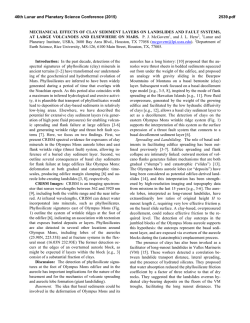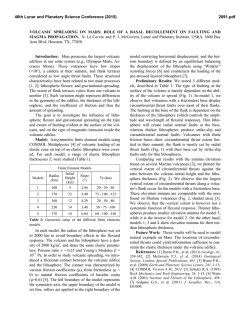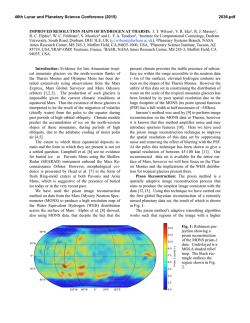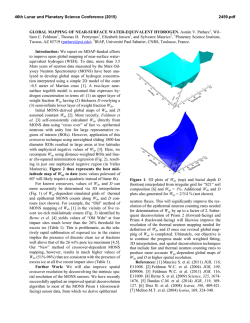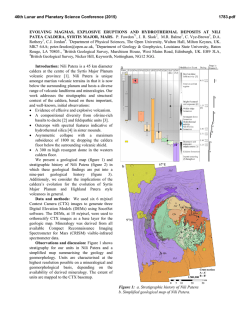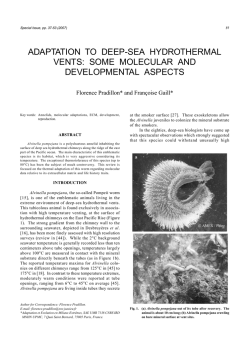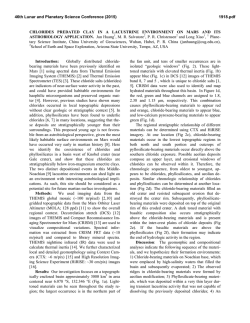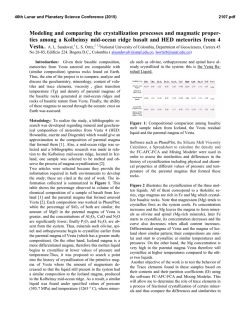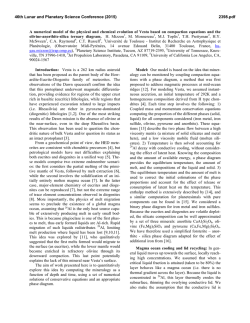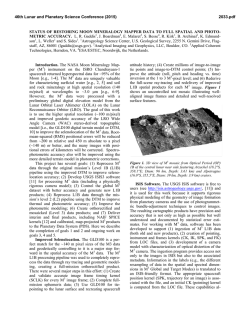
THE DISTRIBUTION AND IMPLICATIONS OF FLANK VENTS ON
46th Lunar and Planetary Science Conference (2015) 2008.pdf THE DISTRIBUTION AND IMPLICATIONS OF FLANK VENTS ON OLYMPUS MONS. S. I. Peters1 and P. R. Christensen1, 1Mars Space Flight Facility, School of Earth and Space Exploration – Arizona State University, 201 E. Orange Mall, Tempe, AZ 85287-6305, USA, [email protected]. Introduction: Flank vents are common features on polygenetic volcanoes, indicating that magma has propagated away from the main conduit and/or magma chamber [1]. The distribution of volcanic vents about a central caldera can provide information on dike propagation and stress orientation in a volcano [1-3]. In addition, the morphology and morphometry of flank vents and associated deposits provide a proxy for eruption style, effusion rate and magmatic properties such as gas content [2, 4]. They have been documented extensively on terrestrial volcanoes such as Mt. Etna and Fernandina volcano (Galapagos Islands) [2, 3]. Similar features are observed on Martian volcanoes. Olympus Mons, the largest shield volcano on Mars at ~23 km, represents ~3 Ga of volcanic activity [5-7]. Located west of the volcano-tectonic Tharsis Province, Olympus Mons is shrouded in spectrally thick dust cover preventing detailed compositional analysis [8]. Consequently, morphology and spatial relationships offer the best chances at understanding the volcanic history of Olympus Mons. The first vent on Olympus Mons was identified using THEMIS VIS (18 m/pix) [9]. A variety of volcanic features and flow morphologies have been identified and mapped using HRSC, providing evidence of effusive eruptions during the Amazonian [4]. Higher resolution imagery has allowed for the identification and characterization of smaller volcanic features. Methods: We mosaicked 159 CTX images (~5 m/pix) covering Olympus Mons in order to identify and map the distribution of vents. We initially identified 22 possible flank vents. Thanks to a new dataset of small volcanic vents in the Tharsis Province, we were able to incorporate an additional 18 vents into the current study [10]. We used MOLA data to determine the dimensions of the vents, the elevation of the vents above the surrounding terrain and the average distance from the center of the volcano to each vent. Using ArcGIS, we performed an average nearest neighbor analysis to determine the spatial distribution of vents. Figure 1: Inset of vent taken from CTX mosaic. Illumination is from the left and north is up. Red arrows represent regional flow pattern. White arrows represent flow from vent. Red arrows illustrate the diversion of flow around vent indicating emplacement subsequent to vent formation. Subsequent flows have not buried vent indicating the vent formed later in Olympus Mons history. Observations: We observed and mapped 40 interpreted flank vents on the slopes of Olympus Mons. The vents are identified as topographically high features with flows emanating from their summits (Fig. 1). In most cases, the vents have diverted subsequent flows around them. The vents average ~1 km across. They range in elevation from 1.5 – 17 km, with an average of 9 km (Fig. 2). The distance between the center of the caldera and the flank vents ranges from ~160 – 340 km, with an average of ~220 km. Average nearest neighbor analysis reveals the vents are clustered. Vents are considered clustered, as opposed to dispersed, if the observed average distance between vents is less than the expected distance between randomly spaced vents. Vents are sometimes associated with linear depressions roughly tangential to contours of the volcano. These linear features are usually a few hundred meters across and several kilometers long. In some instances, material appears to have emanated from these features. Further analyses is needed to understand whether these features represent tectonism, volcanism or a combination of both. 46th Lunar and Planetary Science Conference (2015) Elevation (km) Vent Elevation with Distance from Center of Caldera 20 15 Flank Vents 10 5 0 0 200 400 Distance from Caldera (km) Figure 2: Distribution of vents as a function of elevation and distance from the caldera center. Note the cluster of vents between ~5 – 15 km at ~200 km from the center of the volcano. The occurrence of vents on the lower flanks of Olympus Mons supports the idea of vent migration downslope [5, 7, 11]. Since the observed vents have not been buried, they are the youngest expression of flank volcanism. Discussion: Our results suggest that the formation of observed flank vents is related to preferential magmatic transport and depth of the magma chamber. Dike and sill evolution. The tectonic stresses present at the time of flank vent formation likely influenced magmatic transport. This allowed dikes and sills to propagate outward hundreds of kilometers. A radial orientation of the vents would suggests the magma responded to a radial σ3 (minimum stress) stress field[2]. The stress field on Olympus Mons is probably a result of compression due to gravitational relaxation of the edifice consistent with the observation of thrust faulting in the upper flanks [11-13]. Clustering of the vents implies formation via a common source or mechanism. This may imply that vents are forming primarily along a few preferential pathways. Furthermore, this suggests the effects of regional tectonism on the formation of the observed vents is limited. Depth of magma chamber. The depth of the Olympus Mons magma chamber has been modeled at 13 to 16 km below the summit of the volcano or approximately 7 to 10 km above the surrounding terrain[13, 14]. We found that 29 of the 40 flank vents occur at elevations between 8 – 14 km. The elevation of the vents combined with the modelled depth of the magma chamber suggests nearly lateral transport of magma, perhaps produced by sill and dike propagation away from the magma chamber. Tectonism or Volcanism. The linear depressions associated with some of the flank vents may represent extensional features, volcanic fissures or some combination of both. Some models have predicted the greatest extensional stresses would occur on the lower flanks [11]. If these linear depressions are a result of faulting, it could support the existence of a filled magma chamber [14]. They could also represent a stress field due to the flexure of lithosphere beneath the volcano [11, 13]. A 2008.pdf more detailed analysis of the morphology and morphometry of these linear features and their relationship to flank vents is necessary to ascertain their origin and implications. Ongoing and Future Work: The current project aims to continue incorporating vents into our study for spatial analyses [10]. This will include updated average nearest neighbor analyses and the distribution of vents as a function of elevation. We will attempt spectral analysis using the THEMIS DCS technique in order to obtain compositional information. THEMIS DCS imagery highlights a suite of compositional and thermophysical properties associated with surfaces. Therefore, despite an optically thick dust cover, spectral variations indicate true differences in surface properties. In addition, we plan to use digital elevation models (DEMs) constructed from CTX and HiRISE images to calculate volume estimates and characterize flow morphologies. Acknowledgments: Special thanks to PhD student Jonathon Hill (ASU) for providing insight on the mosaicking procedure and post-doc Mark Salvatore (ASU) for helpful feedback on the abstact. We are also very grateful to PhD student Jacob Richardson (USF) for the introduction of a very helpful dataset. References: [1] Nakamura, K. (1976) J. Volcanology and Geothermal Res., 2, p. 1-16. [2] Rowland, S. K. (1996) J. Geophysical Res., 101, p. 27,657 – 27, 672. [3] Corazzato, C. and Tibaldi, A. (2006) J. Volcanology and Geotherm. Res., 158, p. 117 – 194. [4] Bleacher, J.E. et al. (2007) JGR, 112. [5] Car, M.H. (1973) JGR, 78, p. 4049 – 4062. [6] Blasius, K.R. and Cutts, J.A. (1981) Icarus, 45, p. 87 – 112. [7] Carr, M.H. et al. (1977) JGR, 82, p. 3985 – 4015. [8] Christensen, P.R. (1986) JGR, 91, p. 3533 – 3545. [9] Mouginis-Mark, P.J. and Christensen, P.R. (2005) JGR, 110. [10] Bleacher, J.E. et al. (2010) LPSC XLI, Abstract #1615. [11] McGovern, P.J. and Solomon, S.C. (1993) JGR, 98, p. 23,553-23,579. [12] Byrne, P.K. et al. (2009) Earth and Planetary Science Letters, 281, p. 1 – 13. [13] Thomas, P.J. et al. (1990) JGR, 95, p. 14,345 – 14, 355. [14] Zuber, M.T. and Mouginis-Mark, P.J. (1992) JGR, 97, p. 18, 295 – 18, 307.
© Copyright 2025
